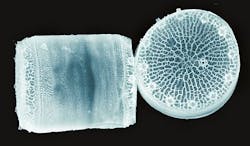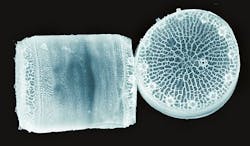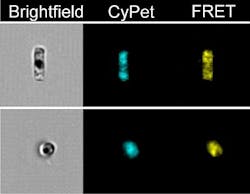Fluorescent biosensor could shine a light on future nanomaterials
Researchers at the Department of Energy's Pacific Northwest National Laboratory (PNNL; Sequim, WA) have developed a biosensor that includes fluorescent proteins embedded in a diatom shell (a type of marine algae that make up the bulk of phytoplankton) that alter their glow when they are exposed to a particular substance. Resembling tiny glass sculptures, the diatom can glow in response to an external substance, potentially helping researchers to develop a variety of new, diatom-inspired nanomaterials that could solve problems in sensing, catalysis, and environmental remediation.
PNNL Laboratory Fellow and corresponding author Guri Roesijadi found inspiration for this biosensor in previous work by other researchers, who showed it's possible to insert proteins in diatom shells through genetic engineering. Using that work as a starting point, Roesijadi, lead author Kate Marshall, and their PNNL colleagues aimed to use fluorescent proteins to turn diatoms into a biosensor. They specifically aimed to create a reagent-less biosensorâone that detects a target substance on its own and without depending on another chemical or substance.
As a test case, the PNNL team inserted genes for their biosensor into Thalassiosira pseudonana, a marine diatom whose shell resembles a hatbox. The new genes allowed the diatoms to produce a protein that is the biosensor.
At the heart of the biosensor is the ribose-binding protein, which, as the name suggests, attaches to the sugar ribose. Each ribose-binding protein is then flanked by two other proteinsâone that glows blue and another that glows yellow. This three-protein complex attaches to the silica shell while the diatom grows.
In the absence of ribose, the two fluorescent proteins sit close to one another. They're close enough that the energy in the blue protein's fluorescence is easily handed off, or transferred, to the neighboring yellow protein. This process, called fluorescence resonance energy transfer (FRET), is akin to the blue protein shining a flashlight at the yellow protein, which then glows yellow.
But when ribose binds to the diatom, the ribose-binding protein changes its shape. This moves the blue and yellow fluorescent proteins apart in the process, and the amount of light energy that the blue protein shines on the yellow protein declines. This causes the biosensor to display more blue light.
Regardless of whether or not ribose is bound to the diatom's biosensor, the biosensor always emits some blue or yellow glow when it's exposed to energy under a microscope. But the key difference is how much of each kind of light is displayed.
The PNNL team distinguished between light from the two proteins with a fluorescence microscope that was equipped with a photon sensor. The sensor allowed them to measure the intensities of the unique wavelengths of light given off by each of the fluorescent proteins. By calculating the ratio of the two wavelengths, they could determine if the diatom biosensor was exposed to ribose, and how much of ribose was present.
The team also succeeded in making the biosensor work with the shell alone, after it was removed from the living diatom. Removing the living diatom provides researchers greater flexibility in how and where the silica biosensor can be used. The Office of Naval Research, which funded the research, believes biosensors based on modifying a diatom's silica shell may prove useful for detecting threats such as explosives in the marine environment.
Co-authors on the paper include scientists at EMSL, DOE's Environmental Molecular Sciences Laboratory at PNNL's Richland, WA, campus. They used EMSL's mass spectrometry capabilities to verify the team had the correct ribose-binding and fluorescent proteins before adding them to the diatoms.
The team's work has been published this week in PLoS ONE. For more information, please visit http://dx.plos.org/10.1371/journal.pone.0033771.
-----
Follow us on Twitter, 'like' us on Facebook, and join our group on LinkedIn
Follow OptoIQ on your iPhone; download the free app here.
Subscribe now to BioOptics World magazine; it's free!


